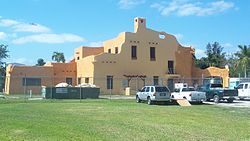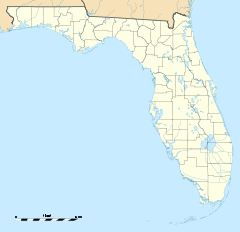- Glenn Curtiss House
-
Glenn Curtiss House

Location: Miami Springs, Florida Coordinates: 25°48′35″N 80°17′1″W / 25.80972°N 80.28361°WCoordinates: 25°48′35″N 80°17′1″W / 25.80972°N 80.28361°W NRHP Reference#: 85003579 Added to NRHP: December 21, 2001 The Glenn Curtiss House (also known as the Miami Springs Villas House or Dar-Err-Aha or MSTR No. 2) is a historic home in Miami Springs, Florida. It is located at 500 Deer Run. On December 21, 2001, it was added to the U.S. National Register of Historic Places.
It is a historical landmark that was constructed in 1925 by aviation pioneer Glenn Hammond Curtiss, developer of the Miami suburbs of Hialeah,and Opa-Locka, Florida, as well as Miami Springs, Florida, where the mansion is located. Curtiss lived at this large, two-story residence designed in the Pueblo Revival style, until his death in 1930.
Contents
History
Facing the eastern perimeter of the golf course, it features a central patio and was the largest of Pueblo theme houses built by Curtiss-Wright company in their development of Country Club Estates. The beautifully landscaped estate covered over 30 acres (120,000 m2) with a small lake on the east side of the property. Mr. Curtiss brought to the lake many species of water birds including flamingos and swans. Including the adjacent property, it formed a 21-acre (85,000 m2) complex. After Glenn Curtiss's death in the early 1930s, Lena Curtiss married an old friend and business associate of her husband, H. Sayre Wheeler. Wheeler served as mayor of Miami Springs from 1942 to 1944 and was also part owner of the Michaels and Wheeler Insurance Company. The couple lived in the house until the late 1940s. The estate was sold in the mid-50's and became the world renowned Miami Springs Villas. It was sold to Forte Hotels, International, Inc. in the late 1970s and is currently owned by Manor Care, Inc.. Designated as a Miami Springs historic site in 1987. The mansion is determined eligible to be placed on the NRHP.
Architecture
Its architect, Martin Luther Hampton, was one of Miami's most prominent architects during the 1920s—his designs include the former Miami Beach City Hall and the Congress Building in downtown Miami. The house is roughly V-shaped in plan and constructed of hollow clay tile with a rough textured stucco exterior. The roof is flat with very irregular parapet walls embellished by projecting waterspouts and irregular shaped openings. The main entrance to the residence is set within a deeply recessed T-shaped opening and marked by a flat-roofed porte cochere. At the south end of the lake is an arbor and barbecue grill. The grill was constructed of oolitic limestone (coral rock), which was a by-product of digging the lake.
Destruction
From the '70s until late 2002, it was a place of vandalism and a number of fires that have destroyed the house. The most devastating and last of those was in 2002, before it was closed to the public.
Future plans
The Glenn Curtiss House is currently being restored and will re-open for events Summer 2011.[citation needed]
See also
- Opa-locka Airport
- Wright brothers
- Curtiss-Wright Corporation
Sources
- http://www.cr.nps.gov/nr/travel/aviation/gle.htm Accessed in 2006
External links
Categories:- Houses on the National Register of Historic Places in Florida
- Houses in Miami-Dade County, Florida
- National Register of Historic Places in Miami-Dade County, Florida
- Proposed museums in the United States
Wikimedia Foundation. 2010.

